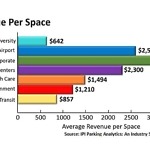Shared parking creates revenue opportunities and reduces space demands

Nobody likes to see spots in a permitted lot sitting empty as they circle looking for available space. At least a “Garage full: monthly permit holders only” sign tells us someone is either using those spaces or paying for them.
By using a shared parking approach, parking authorities can eliminate empty spots when demand for spaces exists.
Shared parking is the use of parking spaces by multiple groups who want those spaces on different days and times. It is most common in downtown and areas of mix-use development; however, it can be successful in other areas where density is high.
What is typical however is that the area has a demand for parking throughout the day and during most days of the week. A typical example is a downtown office space with underground parking that is used by employees during the day, movie and restaurant patrons in the evening, and downtown shoppers on the weekend.
In some cases, parking can be technically oversold, and in these cases, the thought is that vehicles (and owners) will ebb and flow throughout the day. Even in the case of an office environment, not everyone will be at work every day and those that are maybe ride-sharing or take another form of transportation. Some organizations will actually do spot checks now and again to determine the amount of overselling that would be supported during different times of the year.
In this case, the discussion is more about shared parking, but the concept is the same.
It can be complicated but doesn’t have to be
There are many shared parking scenarios with multiple combinations of public and private groups. The Urban Sustainability Directors’ Network convening findings in the spring defined some common models for shared parking that can involve both the private and public sectors:
- Facilities are available to the public always
- Facilities are usually open to the public, but enough capacity is reserved to ensure space for monthly permit holders
- Spaces are rented to the public only when the businesses in the building close.
- Spaces are rented to the public only on a long-term basis (e.g., month-to-month), to minimize security concerns about access to locked garages
However, it can be as simple as one building owner with parking space capacity renting those spaces to another business when they would otherwise be empty. That scenario, in fact, can be a profitable one.
Profit from shared parking
The Victoria Transport Policy Institute (VTPI) provides a great example of a shared parking scenario and how the numbers can translate into profit.
In their example, an office building has 120 surface parking spaces, 100 used by their employees, and the remaining designated for visitors. By negotiating the use of the surface parking spaces for nearby businesses, in this example, a restaurant and a church, the building owner can add $15,000 per year in revenue.
A commercial parking operator factors into the plan for evenings and weekends for an estimated $10,000 in annual revenue. The example also explores the impact of reducing parking spot demand of the building employees through a space-share program. Leasing the freed-up spaces to a nearby business can add $20,000 in revenue.
The report goes on to expand the scenario. However, the example is clear that parking spaces in high demand can offer opportunities for revenue generation and a reduction in traffic congestion.
| Cost | Income | Balance | |
|---|---|---|---|
| Annual rent for the building costs include debt servicing and operating expenses | $900,000 | $1,000,000 | $100,000 |
| Restaurant negotiates 20 spaces for use by staff in evenings and weekends at $50/month/space requires walkway improvements between locations and additional operating expenses | $2,000 | $12,000 | $110,000 |
| Church rents 50 spaces for Sunday mornings at $500/month requires additional operating expenses | $1,000 | $6,000 | $115,000 |
| Commercial parking operator rents unused spaces to the public during evenings and weekends | – | $10,000 | $125,000 |
| Building manager initiates a shared-space program for employees, reducing the demand for 80 spaces for employees, and offering a $40/month cash-out option for those who opt-in. Freed spaces rent to a nearby business for $80/month costs include cash-out payments and additional operating expenses | $12,000 | $32,000 | $145,000 |
Where this works best
While this example creates a straightforward approach to shared parking, not all businesses with surface parking are ideal candidates. These scenarios are limited to areas where parking is in demand and space is at a premium. It also requires that the different user groups in the area have different requirements for parking.
A typical scenario would have weekday users like banks, offices, schools, and factories. They would mix with evening-demand businesses like restaurants, pubs, event facilities, and theaters. Weekend demand comes from parks, churches, shopping centers, and events.
The impact on parking supply
VTPI suggests that a shared parking approach can reduce the amount of parking required at a destination by between 10 and 30%. The graph below shows how parking requirements decrease under a shared supply scenario. This is using residential, office, and restaurant demand in each area.
Demand for parking varies from each group throughout the day, making up different proportions of the parking requirements. However, the overall demand for spaces declines under the shared parking model.
The Institute for Transportation & Development Policy (ITDP) claims shared parking can go even further and reduce supply requirements by as much as 20-40%. However, the scenarios they describe require fully publicly accessible parking. This means no private or reserved spaces and the elimination of free parking.
ITDP explains a scenario in a mixed-use district where demand for spaces would vary by time of day between residential, office, shopping, and community facility demands. Their model of shared parking would require a city-wide approach including zoning reviews, parking usage reviews, and a shift “away from trying to satisfy all parking demands by increasing parking supply.”
This model is most successful when the City adopts a culture of alternative transportation including public transit, cycling, and walking.
Other shared parking opportunities
Un-bundling parking can also offer opportunities for creating shared parking scenarios. For example, a condominium development has a minimum parking requirement of two spaces per unit. They might consider un-bundling the cost of the parking spaces to the condo owner. A condo owner pays less for a unit with one space instead of two. The developer rents the space to the public or a nearby business.
In neighborhoods with residential permitting, understanding the occupancy rates during daytime can allow municipalities to issue daytime permits to non-residents who work in the area. In this example, residents could park free, and the fee for non-resident permits set at a rate that maintains a desired 15% vacancy.
Municipalities could allow for the leasing of shared spaces to help satisfy the minimum parking requirements for new development. These are early-stage decisions of development to help support more cost-effective infill opportunities.


